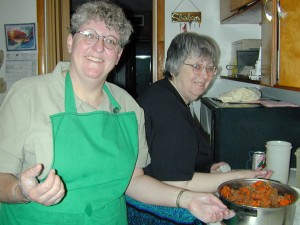
Brisket Girls, 2001
Passover has always been the big holiday in our family, when generations of us gather around several big tables for a delicious meal. But before the food is served, there is the required telling of the Passover story, how the Jews were slaves in Egypt, and how God led them through the desert for 40 years to the promised land.
A big part of Passover for some Jews is the actual preparing for the holiday. For many Jews, in addition to only eating food that is sanctioned “Kosher for Passover,” you also have to use different dishes and silverware during the eight day holiday.
Growing up in a Conservative Jewish household, this meant emptying all of the dishes out of the cabinets and replacing them with the special Passover dishes. And we didn’t have just one set of dishes. We had a complete set of dishes for meat foods and a complete set of dishes for dairy foods, as well as the fancy china for special occasions.
The days before Passover, all three sets of dishes had to be wrapped in paper, boxed up and moved into the garage and replaced with the three sets designated for Passover.
When I reached my teens I rebelled. It seemed like an awful lot of work for just one week. I remember asking my mother, “Can’t we just TELL the story of being slaves in Egypt without having to re-enact it?”
My mother said that, as long as I was living in her house, I was expected to help out.
Many years later, it became too much work for my mother to switch out all of the dishes, even with my help. So instead, she kept the every day dishes in the cabinets and used the special china for the Seder. She included a few dishes from her mother’s flowered Passover dishes and that, my mother said, made it special.
My earliest Passovers were spent at my grandparents’ house, eating off of those flowered dishes. My grandfather sat at the head of the table that ran from the far end of the dining room to the other end of the living room, and all of my aunts and uncles and cousins were there, and he would read in Hebrew from the Haggadah, the Passover story. We ate bitter herbs with matzoh, and celery dipped in salt water, the symbolic foods that remind us of the hardship and sorrow of being slaves.
Even though she had a chair at the table, my grandmother, Bub, spent most of the evening in the kitchen. She and her housemaid, Pearl, had slaved in the kitchen for several days before, preparing chicken soup and kneidels, gefilte fish, and the rest of the many course meal.
Bub made her gefilte fish from scratch, first grinding chunks of carp and whitefish in the meat grinder, then mixing in salt and pepper, and sautéed celery, carrots and onions. I remember running through the house on Gefilte Fish Day, holding my breath and my nose until I was far from the smells of the kitchen.
My mother preferred to use Rokeach brand canned gefilte fish, but she “doctored it up” so that it tasted more like Bub’s. She’d add carrots and celery to the gelatinous broth to thin it out and give the fish more of a homemade flavor. The consistency was different, but it was almost as good as Bub’s.
When we moved away from the family, our Seders were smaller, so my parents encouraged me to invite a friend or two, even if they weren’t Jewish. My father sat at the head of the table, his chair draped with the traditional sheet and pillows that made this night different than all the rest. He and I took turns reading the prayers and passages in Hebrew from the red Passover Haggadah books while the rest of the participants read the English translations.
Several years ago my father asked me to take over as the leader of the Seder service. With me at the head of the table, our Seders became more modern as I incorporated contemporary analogies into the traditional story that we’d been reading every year from the same red Haggadahs.
I shortened the actual service, but still included all of the favorite songs and the stories of the symbolic foods on the Seder plate. And always, we sang Dayenu, and ended with the traditional wine glass raised toast, “Next year in Jerusalem.”
But the highlight of the Seder became the gathering of friends and family and the Festival meal: chicken soup with kneidels, gefilte fish on a bed of salad, my mother’s famous brisket and gravy, with sweet carrot tsimmis, roasted potatoes, crispy, almost burned, just the way Ruth likes them, string beans with almonds and finally, red Jello with fresh fruit in it, and a platter of assorted Kosher for Passover desserts: chocolate covered jelly rings, mandel cuts, candy fruit slices and Manischewitz macaroons.
Last Passover, my mom was finishing the last of many rounds of chemo and she just wasn’t up to cooking. So we pared down the menu and Marika and I agreed to do everything.
Marika borrowed my mother’s big frying pan and the jars of apricot preserves and Chinese duck sauce, the secret ingredients that made my mom’s brisket deliciously sweet. Marika cooked the brisket at her house, preparing it the way she and my mother had been doing together for the last few years.
I agreed to make the gefilte fish. I followed my mother’s dictated directions, emptying the broth and gelatin from the cans into a saucepan with freshly sliced celery and carrots and letting it all simmer. I added the fish to the broth and simmered some more. I forgot how much it stunk up the kitchen.
The night of the Seder, we sat around my parents’ dining room table, me at the head, and my mother, across from me at the other end of the table. Marika and my father flanked me on either side, two of my best friends and three of my parents’ friends filled the remaining chairs.
Instead of the usual reading from the old red Passover books, we just talked, sharing stories of Passovers past, remembering people who were no longer alive. We told the story of how we were slaves in Egypt and we ate the symbolic food from the Seder plate. And we sang “Dayenu,” my mother’s favorite song of thanks.
And then we served the Festival meal. There was no chicken soup with kneidels, no salad under the gefilte fish. But the fish tasted just like my mom’s and everyone said it was delicious.
There were quick-steamed string beans, mashed potatoes and plenty of sweet Mogen David Kosher for Passover wine. But the star of the meal was the brisket. It was sweet and tender, melt-in-your-mouth heaven. My mother was thrilled that she had passed on the recipe so successfully.
At the end of the meal, we lifted our wine glasses and toasted, “Next year in Jerusalem,” signifying the closing of the Seder. And then my mom added, “Next year at Marika’s.”
This morning, at the grocery store, I stood in the Kosher for Passover section. There were the mandel cuts, and the candy fruit slices and the chocolate covered jelly rings. Last year at this time, I had filled my shopping cart with two of everything, in preparation for what was to be my mother’s last Passover Seder. As I stood in front of the cans of coconut macaroons the tears just rolled.
I had decided that this year I would let Passover just pass me by. No Seder, no matzoh, no singing my mother’s favorite songs. Not because I didn’t want the burden of all of the food preparation, but because I couldn’t imagine a Seder without my mom.
But then I realize that she is with me. She is in the stories. She is in the gelatinous broth of the gefilte fish. She is in the brisket and the sweet Mogen David wine and the crispy, almost burned, just the way I like them roasted potatoes.
I don’t need to have a Seder to remember this. But today I realize that I WANT to. And so I will “doctor” some gefilte fish and bring out those old red Passover books. And I will hear my mother’s voice as I sing Dayenu, her favorite song of thanks.
